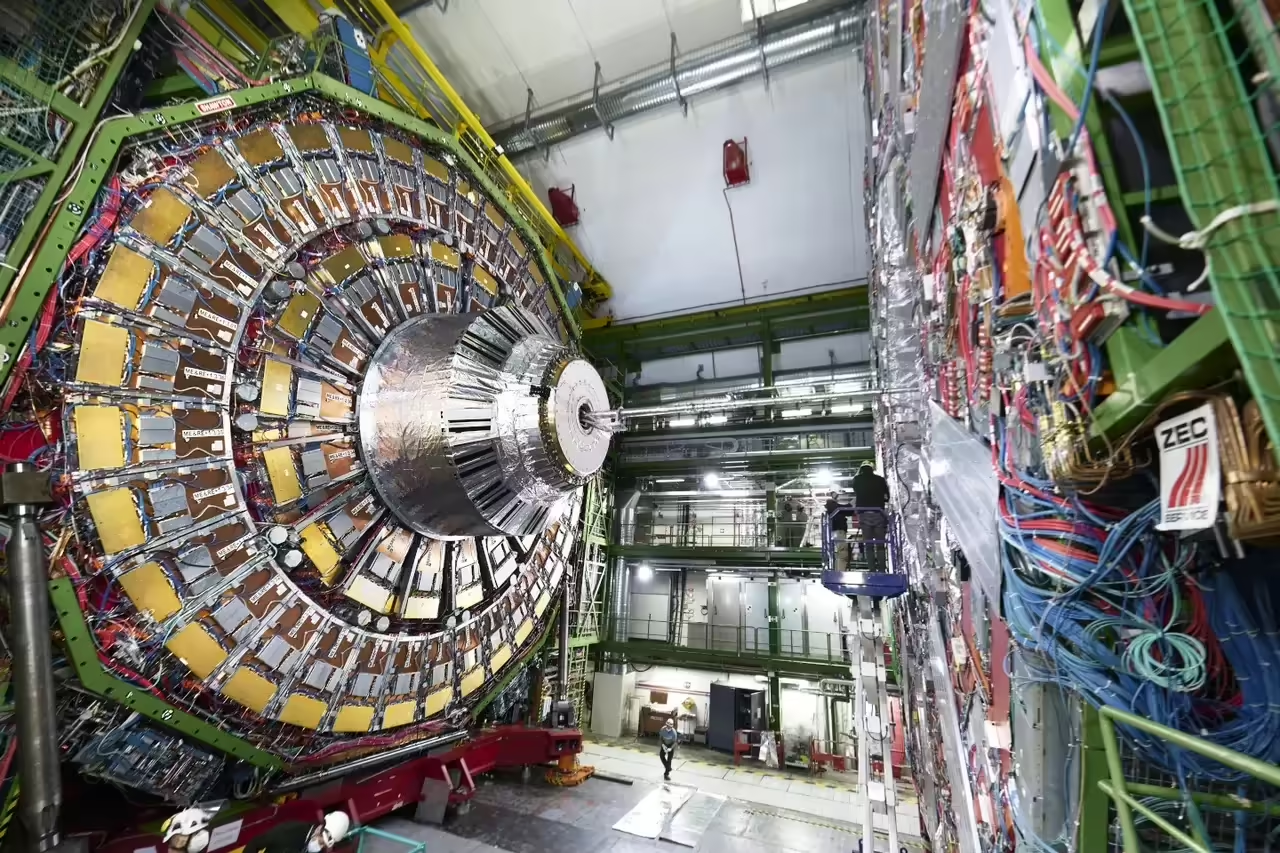
From the most intimate corners of the atom to the far reaches of the cosmos, humanity has tirelessly sought to understand the mysteries of the universe that surrounds us. In this relentless quest for knowledge, one institution stands out as a beacon of discovery: the European Organization for Nuclear Research, commonly known as CERN.
CERN, located on the border between Switzerland and France, is the epicenter of particle physics, a fascinating branch of science that studies the fundamental particles that make up our universe and the forces that govern their interaction. Founded in 1954, CERN has been home to some of the most ambitious and revolutionary scientific experiments in modern history.
At the heart of CERN’s mission lies the Large Hadron Collider (LHC), a marvel of engineering and science that accelerates subatomic particles to speeds approaching the speed of light and smashes them together. These collisions generate energies so colossal that they recreate the conditions that existed in the moments immediately after the Big Bang, allowing scientists to study phenomena that would otherwise be inaccessible.
One of CERN’s greatest achievements was the discovery of the Higgs boson in 2012. This particle, predicted decades earlier by the Standard Model of particle physics, is crucial to our understanding of how elementary particles acquire their mass. Its discovery confirmed the validity of the Standard Model and opened new doors for scientific exploration.
However, CERN’s work extends beyond the search for the Higgs boson. Experiments conducted at its facilities explore a variety of phenomena, from antimatter to dark matter, to the existence of additional dimensions in the universe. Each discovery raises new questions and brings us closer to unraveling the deepest secrets of the cosmos.
In addition to its scientific endeavors, CERN also serves as a model of international cooperation. With the participation of thousands of scientists from around the world, CERN fosters collaboration among countries, cultures, and disciplines, demonstrating that science is a global effort that transcends political and geographic boundaries.
Particle Physics Experiments: What is CERN Seeking?
Particle collider experiments conducted at the European Organization for Nuclear Research (CERN) seek to answer some of the most fundamental questions about the nature of the universe. These experiments are primarily carried out at the Large Hadron Collider (LHC), one of the largest and most complex scientific facilities ever built. Here is an overview of what CERN seeks through these experiments:
Higgs Boson and the Origin of Mass
One of the main goals of the LHC was to find experimental evidence of the Higgs boson, an elementary particle predicted by the Standard Model of particle physics. The discovery of the Higgs boson in 2012 confirmed the existence of this particle and provided a deeper understanding of how elementary particles acquire their mass.
Dark Matter
Dark matter is estimated to constitute about 27% of the universe, but its nature remains largely a mystery. Experiments at the LHC indirectly seek evidence of particles that could be components of dark matter, using the detection of missing particles or unusual phenomena in high-energy collisions.
Antimatter and Matter-Antimatter Asymmetry
The universe appears to be primarily composed of matter, with very little antimatter. However, according to current theories, equal amounts of matter and antimatter should have been produced during the Big Bang. Experiments at the LHC seek to understand this asymmetry and how the universe formed as we know it today.
Particle Physics Beyond the Standard Model
Although the Standard Model of particle physics has been highly successful in predicting and explaining subatomic phenomena, there are many questions it cannot answer. Experiments at the LHC seek evidence of new particles or interactions that could challenge or extend the Standard Model, such as supersymmetric particles or additional dimensions of space.
Origin of the Universe and Extreme Conditions
By recreating the extreme conditions that existed just after the Big Bang, the LHC allows scientists to study how elementary particles and the fundamental forces of the universe formed. This research sheds light on the processes that gave rise to the universe as we know it today.
String Theory and Extra Dimensions: What Are the Other Dimensions?
String theory is one of the most fascinating proposals in contemporary theoretical physics that attempts to describe the most fundamental structure of the universe. This theory suggests that, instead of point-like particles, the fundamental entities are one-dimensional “strings” that vibrate in different modes to give rise to the different particles and forces we observe in the universe.
An intriguing implication of string theory is the idea that our universe could have more dimensions than the three spatial dimensions and one temporal dimension we observe in everyday life. In string theory, these additional dimensions may be compact and curled up on themselves at extremely small scales, making them unobservable in our daily experiences.
Additional dimensions are commonly visualized as “extra” compared to the familiar three spatial dimensions (length, width, and height). Imagine living on a two-dimensional sheet of paper, where you can only move forward, backward, left, and right. If there were an additional dimension, it would be curled up and imperceptible to you unless you could step off the sheet and move in that extra dimension.
In string theory, these additional dimensions are essential for reconciling the different fundamental forces of nature (gravity, electromagnetism, weak nuclear force, and strong nuclear force) into a coherent theoretical framework. It is postulated that strings vibrate not only in the three observable spatial dimensions but also in the extra dimensions, giving rise to different modes of vibration and, therefore, different particles and physical phenomena.
Exploring Additional Dimensions in Particle Physics
Exploring additional dimensions in the context of particle physics is a fascinating topic that has captured scientists’ imaginations for decades. Although additional dimensions are not directly observable in our everyday experience, physical theories such as string theory and some proposals of grand unification models suggest their existence.
One of the most common ways to address the idea of additional dimensions is through the framework of string theory. According to this theory, fundamental particles are not dimensionless points, as assumed in the Standard Model of particle physics, but rather one-dimensional strings that can vibrate in different modes. String theory requires the existence of additional dimensions, typically six or seven, in addition to the four familiar dimensions (three spatial dimensions and one temporal dimension), for the theory to be mathematically coherent. These additional dimensions are assumed to be compactified or curled up at extremely small scales, making them unobservable at our current energy scales.
In the context of particle collider experiments, such as the Large Hadron Collider (LHC) at CERN, scientists can search for indirect evidence of additional dimensions. For example, the production of supersymmetric particles or the behavior of fundamental forces could provide evidence of the existence of additional dimensions in nature.
Furthermore, experiments at the LHC can search for phenomena that could indicate the existence of additional dimensions. For example, gravity could manifest differently at extremely high energy scales, which could suggest the existence of additional dimensions according to some physical theories.
The Standard Model and Its Limitations: Why Do We Need to Explore Other Dimensions?
The Standard Model of particle physics is an extraordinarily successful theory that describes the fundamental particles and the forces that interact between them. However, despite its success in predicting and explaining a wide range of observed phenomena, the Standard Model has several limitations and unresolved questions. These limitations are some of the reasons why scientists seek to explore other dimensions beyond those we know.
Here are some of the key limitations of the Standard Model:
Does not include gravity: The Standard Model does not incorporate gravity, one of the four fundamental forces of nature. Although the other three forces (electromagnetic force, strong nuclear force, and weak nuclear force) are unified in the Standard Model, gravity remains a separate force. The inclusion of gravity in a coherent theoretical framework is one of the main challenges of current theoretical physics.
Does not explain dark matter or dark energy: The Standard Model does not provide explanations for dark matter and dark energy, which constitute approximately 95% of the universe’s content. These forms of matter and energy are indirectly detected through their gravitational effects, but their fundamental nature remains a mystery.
Does not provide an explanation for matter-antimatter asymmetry: The observed universe is mainly composed of matter, with very little antimatter. However, according to the Standard Model, equal amounts of matter and antimatter should have been produced during the Big Bang. The lack of a convincing explanation for this asymmetry is one of the unresolved problems in particle physics.
Does not solve theoretical problems such as the mass hierarchy: The Standard Model does not explain why the masses of fundamental particles vary so much. This problem, known as the mass hierarchy problem, is especially pronounced in the case of the Higgs boson, whose observed mass is much lower than would be expected based on the contributions of other particles to the calculation of its mass.
Exploring other dimensions, as suggested by string theory and other theories beyond the Standard Model, offers hope of addressing some of these limitations. For example, some theories propose that additional dimensions could help unify all the fundamental forces of nature, including gravity, into a coherent theoretical framework. Additionally, the existence of additional dimensions could provide candidates for dark matter and offer solutions to theoretical problems such as the mass hierarchy.
Experiments at CERN: In Search of Evidence for Extra Dimensions
At the European Organization for Nuclear Research (CERN), experiments are designed to explore the limits of our understanding of the most fundamental structure of the universe. One intriguing objective of these experiments is to seek evidence of extra dimensions beyond the three spatial dimensions and the temporal dimension that we perceive in our everyday reality. While these extra dimensions are not directly observable at our current energy scales, some theoretical models, such as string theory, suggest their existence and could have significant implications for our understanding of the cosmos.
To search for evidence of extra dimensions, scientists at CERN utilize the Large Hadron Collider (LHC) and other particle detection experiments. Although extra dimensions are compact and may be extremely small, theoretically, they could manifest in the high-energy collisions produced by the LHC in several ways:
Production of Massive Kaluza-Klein Particles: In some models of extra dimensions, particles known as Kaluza-Klein modes could be observable in high-energy collisions. These particles are postulated as excitations of known particles due to vibrations in the extra dimensions. Experiments at the LHC seek signs of these massive particles that would indicate the existence of compactified extra dimensions.
Violation of Conservation of Energy-Momentum: The presence of extra dimensions could allow for leakage of energy into those dimensions, which could manifest as a lack of balance in momentum conservation in high-energy collisions. Experiments at the LHC search for anomalies in the distribution of energy and momentum of particles produced in collisions, which could indicate the presence of extra dimensions.
Production of Mini Black Holes: Some theories suggest that the energy from particle collisions at the LHC could be sufficient to produce mini black holes, which could reveal the existence of extra dimensions. If the extra dimensions are compact and accessible through gravity, these mini black holes could be created and detected in experiments.
Gravitational Effects: Gravity could manifest differently at very high energy scales if extra dimensions exist. Experiments could search for signals of deviations from Newton’s law of gravity at subatomic energy scales, which could indicate the existence of extra dimensions.
Although definitive evidence of extra dimensions has not been found thus far, experiments at CERN continue to search for signals of these dimensions beyond our three spatial dimensions and one temporal dimension. The study of extra dimensions represents an exciting field of research that could have a significant impact on our understanding of the universe at fundamental levels.







